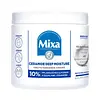What's inside
What's inside
 Key Ingredients
Key Ingredients

 Benefits
Benefits

 Concerns
Concerns

 Ingredients Side-by-side
Ingredients Side-by-side

Water
Skin ConditioningGlycerin
HumectantButyrospermum Parkii Butter
Skin ConditioningIsopropyl Palmitate
EmollientPropanediol
SolventCetyl Alcohol
EmollientMyristyl Myristate
EmollientZea Mays Starch
AbsorbentSqualane
EmollientCarbomer
Emulsion StabilisingSodium Hydroxide
Buffering2-Oleamido-1,3-Octadecanediol
Skin ConditioningHydroxyacetophenone
AntioxidantHydroxypalmitoyl Sphinganine
Skin ConditioningCaprylyl Glycol
EmollientCitric Acid
BufferingPolyglyceryl-3 Methylglucose Distearate
EmulsifyingTocopherol
AntioxidantWater, Glycerin, Butyrospermum Parkii Butter, Isopropyl Palmitate, Propanediol, Cetyl Alcohol, Myristyl Myristate, Zea Mays Starch, Squalane, Carbomer, Sodium Hydroxide, 2-Oleamido-1,3-Octadecanediol, Hydroxyacetophenone, Hydroxypalmitoyl Sphinganine, Caprylyl Glycol, Citric Acid, Polyglyceryl-3 Methylglucose Distearate, Tocopherol
Water
Skin ConditioningGlycerin
HumectantCetearyl Alcohol
EmollientC15-19 Alkane
SolventGlyceryl Stearate Se
EmulsifyingGlyceryl Stearate
EmollientIsopropyl Palmitate
EmollientCera Microcristallina
Emulsion StabilisingDimethicone
EmollientPanthenol
Skin ConditioningPantolactone
HumectantParaffinum Liquidum
EmollientPhenoxyethanol
PreservativeHydrogenated Coco-Glycerides
EmollientCarbomer
Emulsion StabilisingSodium Cetearyl Sulfate
CleansingSodium Hydroxide
BufferingEthylhexylglycerin
Skin ConditioningCitric Acid
BufferingBHT
AntioxidantTocopheryl Acetate
AntioxidantWater, Glycerin, Cetearyl Alcohol, C15-19 Alkane, Glyceryl Stearate Se, Glyceryl Stearate, Isopropyl Palmitate, Cera Microcristallina, Dimethicone, Panthenol, Pantolactone, Paraffinum Liquidum, Phenoxyethanol, Hydrogenated Coco-Glycerides, Carbomer, Sodium Cetearyl Sulfate, Sodium Hydroxide, Ethylhexylglycerin, Citric Acid, BHT, Tocopheryl Acetate
Ingredients Explained
These ingredients are found in both products.
Ingredients higher up in an ingredient list are typically present in a larger amount.
Carbomer is a polymer of acrylic acid. Its main role is to create a gel consistency.
A high amount of carbomer can cause pilling or balling up of products. Don't worry, most products contain 1% or less of carbomer.
Citric Acid is an alpha hydroxy acid (AHA) naturally found in citrus fruits like oranges, lemons, and limes.
Like other AHAs, citric acid can exfoliate skin by breaking down the bonds that hold dead skin cells together. This helps reveal smoother and brighter skin underneath.
However, this exfoliating effect only happens at high concentrations (20%) which can be hard to find in cosmetic products.
Due to this, citric acid is usually included in small amounts as a pH adjuster. This helps keep products slightly more acidic and compatible with skin's natural pH.
In skincare formulas, citric acid can:
While it can provide some skin benefits, research shows lactic acid and glycolic acid are generally more effective and less irritating exfoliants.
Most citric acid used in skincare today is made by fermenting sugars (usually from molasses). This synthetic version is identical to the natural citrus form but easier to stabilize and use in formulations.
Read more about some other popular AHA's here:
Learn more about Citric AcidGlycerin is already naturally found in your skin. It helps moisturize and protect your skin.
A study from 2016 found glycerin to be more effective as a humectant than AHAs and hyaluronic acid.
As a humectant, it helps the skin stay hydrated by pulling moisture to your skin. The low molecular weight of glycerin allows it to pull moisture into the deeper layers of your skin.
Hydrated skin improves your skin barrier; Your skin barrier helps protect against irritants and bacteria.
Glycerin has also been found to have antimicrobial and antiviral properties. Due to these properties, glycerin is often used in wound and burn treatments.
In cosmetics, glycerin is usually derived from plants such as soybean or palm. However, it can also be sourced from animals, such as tallow or animal fat.
This ingredient is organic, colorless, odorless, and non-toxic.
Glycerin is the name for this ingredient in American English. British English uses Glycerol/Glycerine.
Learn more about GlycerinIsopropyl Palmitate is a texture enhancer and emollient. It is an ester of isopropyl alcohol and palmitic acid.
Palmitates are emollients. Emollients help keep your skin soft and smooth by creating a barrier that traps moisture in.
When added to cosmetics, Isopropyl Palmitate creates a silky texture and improves spreadability.
Isopropyl Palmitate may not be fungal acne safe. It can worsen acne prone skin.
Learn more about Isopropyl PalmitateSodium Hydroxide is also known as lye or caustic soda. It is used to adjust the pH of products; many ingredients require a specific pH to be effective.
In small amounts, sodium hydroxide is considered safe to use. However, large amounts may cause chemical burns due to its high alkaline.
Your skin has a natural pH and acid mantle. This acid mantle helps prevent harmful bacteria from breaking through. The acid mantle also helps keep your skin hydrated.
"Alkaline" refers to a high pH level. A low pH level would be considered acidic.
Learn more about Sodium HydroxideWater. It's the most common cosmetic ingredient of all. You'll usually see it at the top of ingredient lists, meaning that it makes up the largest part of the product.
So why is it so popular? Water most often acts as a solvent - this means that it helps dissolve other ingredients into the formulation.
You'll also recognize water as that liquid we all need to stay alive. If you see this, drink a glass of water. Stay hydrated!
Learn more about Water